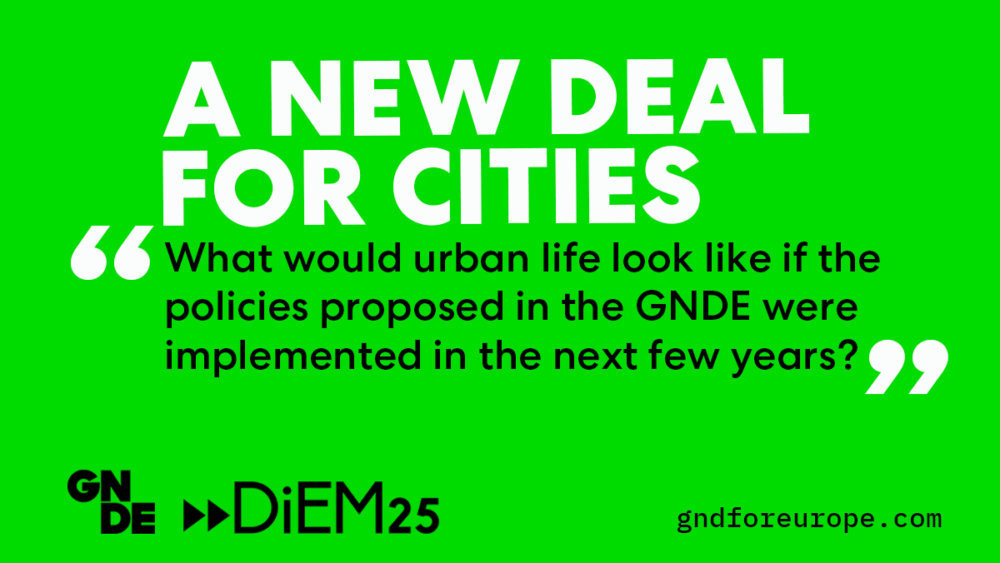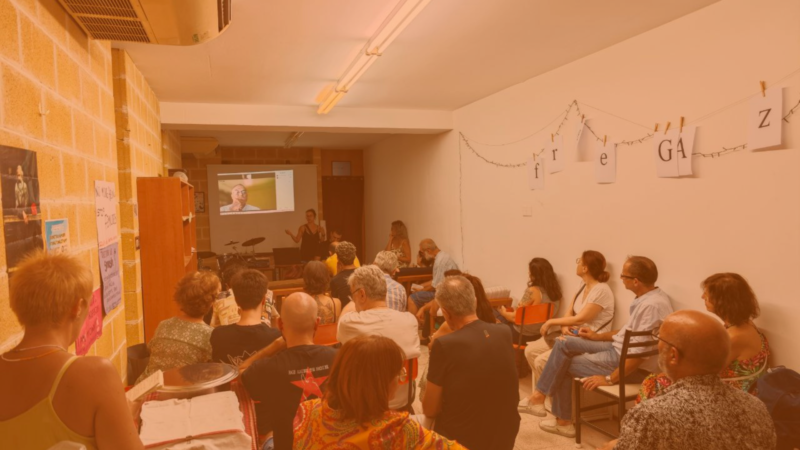A tour through the sustainable neighbourhoods of Milano’s periphery in 2035.
This is a “future vision”, a thought exercise in speculative design. Set fifteen years in the future, it intends to provide a plausible picture of what urban life could look like if the policies proposed in the Green New Deal for Europe blueprint were implemented in the next few years. Let’s follow a future travel journalist in their tour of what are currently some of the most troubled neighbourhoods of Milano and let’s have a look at how everything might change.
What would urban life look like if the policies proposed in the GNDE were implemented in the next few years?
Walking through the busy, colourful streets of Ponte Lambro today, you’d be hard pressed to imagine that only some fifteen years ago, this vibrant, multicultural hub of creative and care work was one of the neighbourhoods at the highest risk of social exclusion in Milano.
Like many peripheral neighbourhoods in the city, Ponte Lambro suffered a great deal from the deindustrialization of the ‘80s and from its lack of connection with the rest of the city. Throughout the ‘90s and the first two decades of the 21st century it was plagued with problems of poverty, lack of services and cultural spaces, poor housing conditions and lack of social cohesion due to the influx of further and further socially excluded groups. In 2020, only a scant 15 years ago, it was still considered a less than desirable place to live, where people washed up only when they had nowhere else to go.
But what has turned Ponte Lambro and the other so-called “urban wastelands” into the thriving communities of today?
The roots of this change can be found in the late ‘10s, when a series of initiatives to transform both the urban fabric and urban life were launched by different social actors in the attempt to transform cities into centres of sustainability by transforming the way people thought about food production, public transport, schooling, healthcare and their communities. Local volunteer associations, social cooperatives and foundations, working in isolation or in larger networks, established permaculture gardens, promoted awareness of sustainable solutions and helped build a sense of community among the different groups living in the neighbourhoods, mediating their expectations and needs.
These local efforts and the aspirations for a better way to experience the city expressed by the people living in those neighbourhoods, however, would have amounted to a drop in the ocean without the support and opportunities provided by the Green New Deal for Europe (GNDE).
Launched in 2020, this set of common policies for the European Union has supercharged these initiatives. On one hand, it provided common decentralised frameworks, created transparent funding mechanisms, as well as initiated technical support that local actors could access to respond to the needs of their community. On the other, it has brought public money towards disadvantaged areas, creating the infrastructure necessary for local actions on housing, sustainable mobility, environmental care, people care and other “glocal” issues to be effective.
The sustainable housing policies included in the GNDE, for example, have enabled the return of a large amount of unused housing stock to communities. In Ponte Lambro and other neighbourhoods, some of this housing stock was assigned to newly-created housing cooperatives, which transformed them into co-housing “villages” organised around community and collective domestic work. Villaggio Canova, at the very edge of the Ponte Lambro neighbourhood, is one of the oldest examples. There, families from different backgrounds and age groups live in self-contained apartments fitted with energy-saving devices and top-grade insulation. All residents share common facilities such as bread ovens, art rooms, playgrounds and smart grid energy generation. A central “common house” hosts periodic parties, cultural events, and assemblies deliberating on the management of the village. As of the time of writing, it is one of the most sought-after places of residence in the whole of South Milano.
Grants to retrofit other public and private housing to the highest environmental standards have also changed the face of the neighbourhoods. Most buildings now sport both solar panels and solar heating, with a few pioneers implementing also more exotic solutions such as MOST catalyst-based solar heating systems.
Since the beginning of the programme, infrastructural investments, from free public transport for residents to the creation of new cycle lanes and of inclusive equipment-sharing schemes for sustainable mobility (bikes, tricycles, and wheelchair attachments to cater for all needs) have greatly reduced the number of cars in the urban area, however the real step change kicked in when the Care Income was implemented.
Paid out to all people working in the care of others or the environment, natural or urban, this European initiative changed the landscape of work throughout the neighbourhoods, opening up opportunities for meaningful local work that was always seen as a necessity but never funded well enough to happen.
Urban restoration projects that had faltered for years suddenly had the opportunity to be completed and neglected parks and green spaces were restored through community-led projects and rewilding. The latter process has affected many formerly degraded areas, including the banks of the main rivers flowing through the city. Famously described as “a river in torment” by songwriter Caparezza in the early 2000s, the Lambro now boasts biodiverse water meadows along its banks, which are a hot spot for excursions and picnics, and has seen the return of many indigenous species of fish. For this the Milanese have to thank the local residents for taking up catfish hunting techniques and cooking recipes from Poland and Romania, which have allowed the use of invasive wels catfish as a source of sustainable protein. Many restaurants now incorporate the slimy menace in their menus. We tried it in one of the small family restaurants situated along the banks of the Lambro, and believe us, it’s as delicious as it is ugly.
Sustainable, local food production has also taken off massively thanks to the new agricultural policies implemented within the GNDE framework. The establishment of urban allotments has exploded in both Molise-Calvairate-Ponti and Gratosoglio at the beginning of the implementation period of the GNDE and now many of the early projects are mature and yield substantial crops of high-quality organic produce that is used in local schools and independent housing communities for the elderly or the disabled. Most restaurants in the neighbourhood also source their food hyper-locally, in part thanks to consortia of micro-allotments set up in interstitial spaces around the urban fabric.
Most schools have their own allotments and, ever since the early ‘20s, permaculture, as well as sustainable food processing and cooking, are staples of the curricula of all levels of schooling, which probably is one of the leading factors in the ever-increasing quality of the food offering. Only in the last five years, Milano has added four new restaurants to the European Golden League of vegan cuisine.
Situated next to the agricultural areas of the Parco Agricolo Sud, Ponte Lambro has been less involved in the urban agriculture movement compared to its sister neighbourhoods. The local assemblies of neighbours have preferred to establish close relations with the rural areas all around it for sustainable food provisioning. Consequent to this decision, the neighbourhood has seen an increase in small cooperatives dedicated to sustainable food processing; including bakeries, breweries and an award-winning conserve factory that serves the best bars and restaurants in the city, which attract foodies from all across the Union with their sustainable dishes, cooked with local ingredients and multicultural flair.
The processes of housing improvement, public transport expansion and work re-localisation have led to the almost complete disappearance of the notorious “cappa” — a permanent cloud of pollution particulate, visible even from satellite images, that used to hover over the city for decades. Now, on bright sunny days, residents and tourists alike can delight in a clear view of the Alps, particularly from the top of the newly-inaugurated Popular European Library.
Initially planned and then abandoned in the early 2000s, the project was taken up once again by huge popular demand at the time of the first participatory budget of the Comune di Milano.
Conceived through one of the finest examples of participative design processes in Europe and perhaps in the world, the library was built according to the most advanced principles of passive architecture, and houses not only a large collection of books, ranging from narrative to reference and research material, in particular on the topics of sustainable living, but an open-air theatre, an indoors auditorium for cultural events, breakout rooms for training and workshops and its own energy generation systems. Its daring spiral structure, inspired by Friedensreich Hundertwasser’s Waldspirale in Darmstadt, is covered in a vertical garden that provides not only a wonderful promenade with one of the best views of the Duomo in the whole of Milano to the thousands of visitors it has received since the inauguration, but also fresh produce for the cafeteria, which, according to the locals, serves the best carrot, beetroot and apple cake in the entire city. All sourced locally, of course.
And believe us, there is nowhere better to settle down with a cup of tea, a book and a piece of cake than the top of the spiral, especially in spring when the sun is setting and the last rays of light colour the still-snowy peaks of the Orobic Alps a radiant pink.
Cheers, or, as they say, Salute!
Laura C Zanetti Domingues and Guglielmo Miccolupi are both members of Commando Jugendstil, a collective of Italian solarpunk creators which has authored several short stories and essays on the transition of cities towards sustainability and the reframing of narratives around the sustainable future.
They are also involved in the EU-funded project “Milano, Cartoline da un Futuro Possibile” (Milan, Postcards from a Possible Future), which aims to empower the citizens of neighbourhoods in Milan to imagine and build their own sustainable future through participative and speculative design. Their article is inspired by this project.
Do you want to be informed of DiEM25's actions? Sign up here










